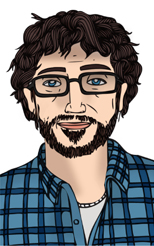
By Scott Ronalds
Meet Bruce. He shares several traits of investors who we deal with every day. In many ways, he is representative of a typical Steadyhand client. In this blog series, we’ll follow his investing journey and provide periodic updates on the decisions and challenges he faces.
Profile
Age: 42
Status: Married
Children: 2 (ages 8 and 10)
Occupation: Software Engineer
Residence: North Vancouver
Likes: The Boss, Running, Single Malt, Modern Family
Dislikes: Windows 7, Cucumbers, Sammy Hagar, Riesling
Steadyhand Client Since: December 2010
Investments:
-
RRSP: $170,000 (Bruce); $100,000 (Courtney)
- TFSA: $12,500 (Bruce); $12,500 (Courtney)
- RESP: $20,000
- Non-registered: $75,000 (Joint)
Bruce is a married forty-something software engineer with two pre-teen kids. His wife, Courtney, works part-time in marketing and the couple makes a combined annual income of approx. $180,000. They own a house in North Vancouver worth roughly $750,000 (with a mortgage of $250,000). Bruce has been investing since the glory days of the early 1990s, but it was just over the past few years that he began to take greater interest in and control of his financial situation. The market downturn of 2008/09 was the catalyst.
Background
Bruce discovered Steadyhand through Tom Bradley’s column in the Globe and Mail. After following the company for a year or so, he and Courtney decided to transfer their RRSPs, TFSAs, and a portion of their non-registered investments to the firm in late 2010. They continue to hold an RESP and joint investment account at a discount broker (Bruce owns a few technology stocks that he follows closely).
The couple had dealt with an advisor at a brokerage firm for several years, but Bruce felt he wasn’t getting a lot of value from the relationship as he was paying for service that he wasn’t getting, he owned too many products, and transparency was lacking. He was tired of dancing in the dark. Bruce felt confident in his abilities to oversee his own portfolio and knew that Steadyhand could provide him with investment advice or at times act as a sounding board for his decisions.
Financial Goals
Bruce would like to retire in his early to mid-60s. Between now and then, he has some key financial goals. In order of importance, they are:
1. Put his kids through university (if they choose).
2. Purchase a recreational property (he has always wanted to own a cottage in the Okanagan, but has been increasingly looking at California and Arizona given their battered real estate markets and the strong Canadian dollar).
3. Grow his portfolio to the $1.5 million mark in today’s dollars (not including his house).
As for non-financial goals, Bruce would like to complete the New York Marathon. To Courtney’s dismay, he’s also expressed an interest in commercial space travel (Virgin Galactic), and would love to jam with the E Street band. As he often tells his wife, crazier things have happened.
Portfolio
Bruce and Courtney are comfortable taking some risk in their portfolio. They have an investment time horizon of 20+ years and do not anticipate any recurring income needs (from their portfolio) until they reach retirement. Their portfolio was hit hard during the market downturn of 2008/09 but they rode out the financial crisis without making any adverse knee-jerk investment decisions, and have since recouped their losses. That said, they aren’t comfortable with a 100% equity portfolio, as they have learned to appreciate the value of diversification in moderating volatility.
After consulting with us, they decided on a strategic asset mix range for their overall portfolio of 65-70% equities / 30-35% fixed income. Bruce has been discouraged by U.S. and overseas stocks and has developed a ‘home country bias’ due to the stronger returns that Canadian stocks have delivered over the past decade. We suggested that he shouldn’t ignore global equities, however, as they should be an important part of any balanced portfolio and currently offer compelling value. The couple took our advice and executed it as follows:
- Savings Fund – 10%
- Income Fund – 30%
- Equity Fund – 24%
- Global Equity Fund – 24%
- Small-Cap Equity Fund – 12%
This is a slight variation of our hypothetical Balanced Equity Portfolio (a position in the Savings Fund was added to the mix). The resulting asset mix is roughly 33% fixed income, 32% Canadian equities, and 35% foreign equities. For tax efficiency reasons, the Income Fund and Savings Fund are held in the registered accounts (RRSPs and TFSAs).
The cash position (Savings Fund) was recommended as a source of dry powder and liquidity in the event that: (1) bonds experience a rise in yields (and drop in prices) or stocks pull back following a period of strong gains; or (2) Bruce requires an early down payment for a vacation property.
The couple’s investments with Steadyhand totaled $340,000 at the beginning of the year ($270,000 RRSPs, $25,000 TFSAs, $45,000 joint investment account). At this level of household assets, their annual all-in fee is roughly 1.10%.
Bruce and Courtney have their financial house in good order. There are sure to be bumps in the road and decisions to make, however, as life plays out. We’ll keep you posted on their progress.

